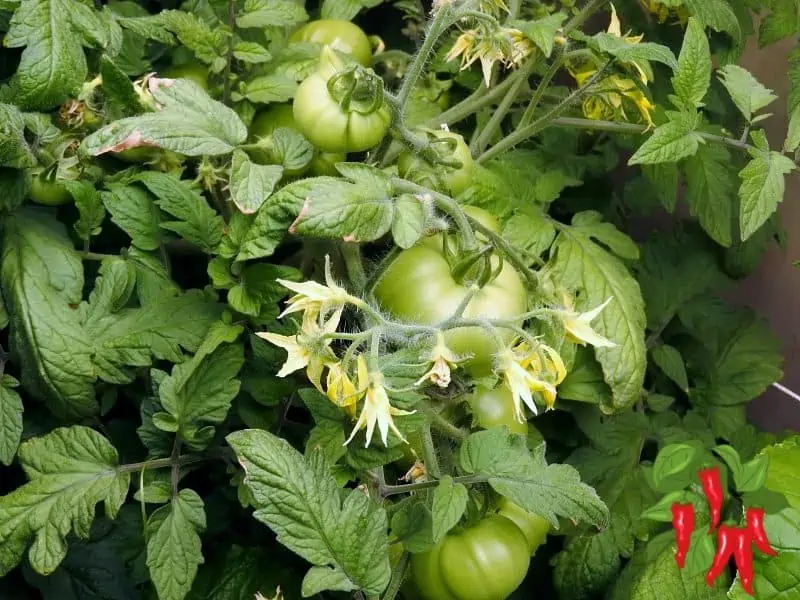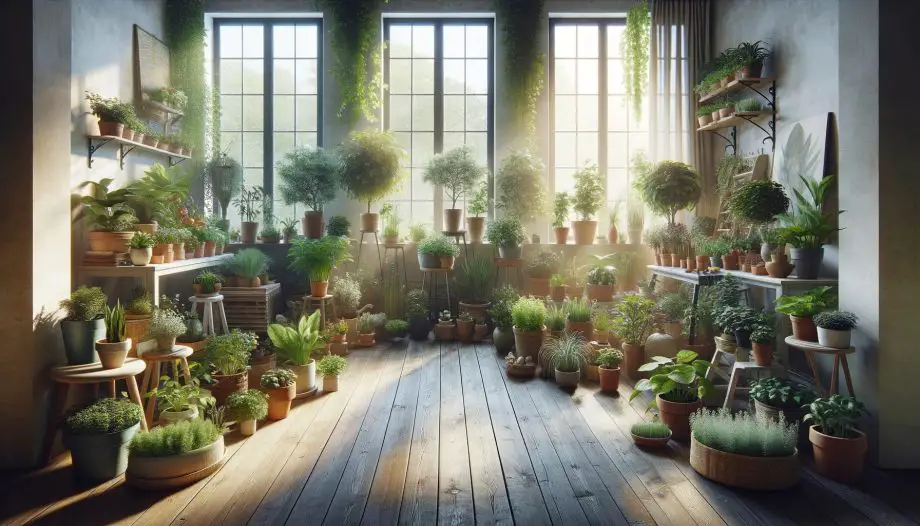This post may contain affiliate links. If you buy something from one of our links we may earn a commission. Thanks
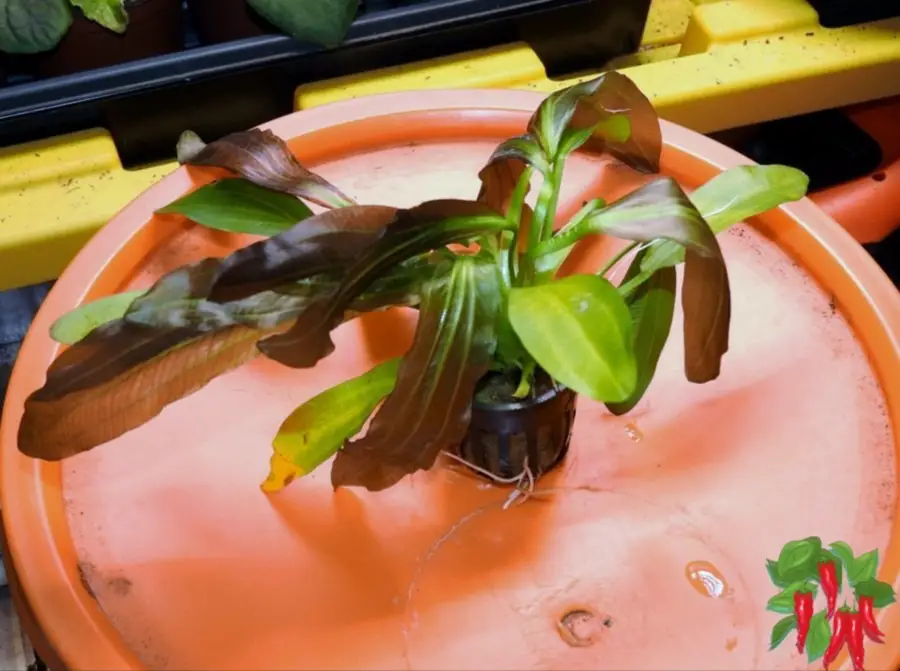
Red Rubin Sword is one of those aquarium plants that makes you do a double-take. You want color? This one’s got deep reds that actually shows up and it’s easy to grow.
If you want to add easy red color or have ever been let down by a “red sword,” this is your upgrade.
Red Rubin Sword Key Takeaways
- Red Rubin Sword is a colorful aquarium plant known for its deep red and burgundy leaves.
- It’s a variety of Echinodorus that’s easy to grow, even for beginners.
- It thrives in low to medium light, especially when planted with root tabs.
- This hardy sword plant adds a bold pop of color to freshwater aquascapes.
Red Rubin Sword: Beginner-Friendly and Beautiful
Want to add a splash of red to your freshwater tank without the hassle? The Red Rubin Sword is perfect for beginners and pros alike.
It brings bold color, simple care, and great growth with minimal effort.
The Red Rubin Sword is a stunning, beginner-friendly plant. Learn how to plant, care for, and grow this vibrant Echinodorus in your aquarium.
Buy Your Own Red Rubin Sword Plant
 CANTON AQUATICS Amazon Sword Echinodorus Red Rubin Small – Fast Growing & Colorful Plant – Mid-Ground Positioning – All Natural & Organic Aquatic Plant – Long Lasting & Easy to Care
CANTON AQUATICS Amazon Sword Echinodorus Red Rubin Small – Fast Growing & Colorful Plant – Mid-Ground Positioning – All Natural & Organic Aquatic Plant – Long Lasting & Easy to Care
🌿 What Is the Red Rubin Sword?
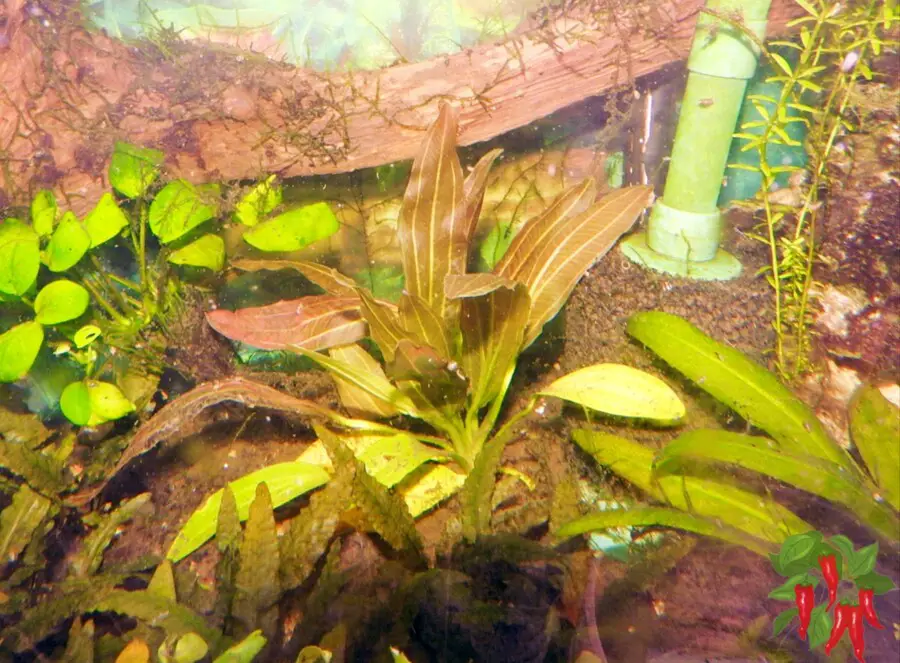
The Red Rubin Sword is a vibrant freshwater plant that brings bold color and easy care to your aquarium. It’s part of the Amazon Sword family and stands out for its striking red tones.
🏷️ Common Names
- Red Rubin
- Red Sword Plant
- Echinodorus ‘Red Rubin’
🔬 Scientific Background
- Botanical name: Echinodorus ‘Red Rubin’
- Family: Amazon Sword (Echinodorus genus)
- Hybrid of:
- Echinodorus barthii
- Echinodorus horemanii
🍁 Why It’s Special
- 🌈 Deep red to burgundy leaves: stunning contrast to green plants
- 🌿 New leaves are more vibrant and fade slightly as they mature
- 🐠 Perfect for planted tanks and peaceful community aquariums
👍 Beginner-Friendly Perks
- Easy to grow
- Low to medium light requirements
- Doesn’t need CO₂ to thrive
This is the kind of plant that makes your tank pop without demanding a lot in return.
Echinodorus are by nature marsh and bog plants that can grow submersed. Many species are grown in aquariums. They prefer good light and grow best in a deep, nutrient-rich substrate. Most will grow in variable water conditions, though the majority need tropical or sub-tropical temperature ranges. https://en.wikipedia.org/wiki/Echinodorus
🌱 Key Features and Growth Habit
The Red Rubin Sword isn’t just another pretty face. It’s got a solid growth habit that makes it both practical and eye-catching in your aquascape.
Whether you’re just starting out or you’ve got a tank full of plants, this one fits right in.
📏 Size and Placement
- Grows about 6 to 12 inches tall
- Ideal for the midground or background of your aquarium
- Can be a focal point in smaller tanks
🌿 Leaf Texture and Color
- Long, sword-shaped leaves with burgundy to reddish-green tones
- Color intensity depends on light and nutrients
- New growth tends to show the deepest reds
🐟 Fish-Friendly Structure
- Broad leaves offer shelter for shrimp and fish
- Hardy enough to handle a little nibbling
- Doesn’t get uprooted easily by digging species
- 🫶 Great for community tanks: peaceful, non-invasive
✅ Care & Conditions
- 🌡️ Temp range: 72–82°F
- 💧 pH range: 6.5–7.5
- 🧪 Water hardness: Soft to moderately hard
- 💡 Lighting: Low to medium (colors deepen with more light)
- 🌱 Thrives in planted tanks with root tabs for extra nutrients
If you’re after a plant that adds color and structure without being a hassle, this sword’s got your back.
🪴 Planting the Red Rubin Sword
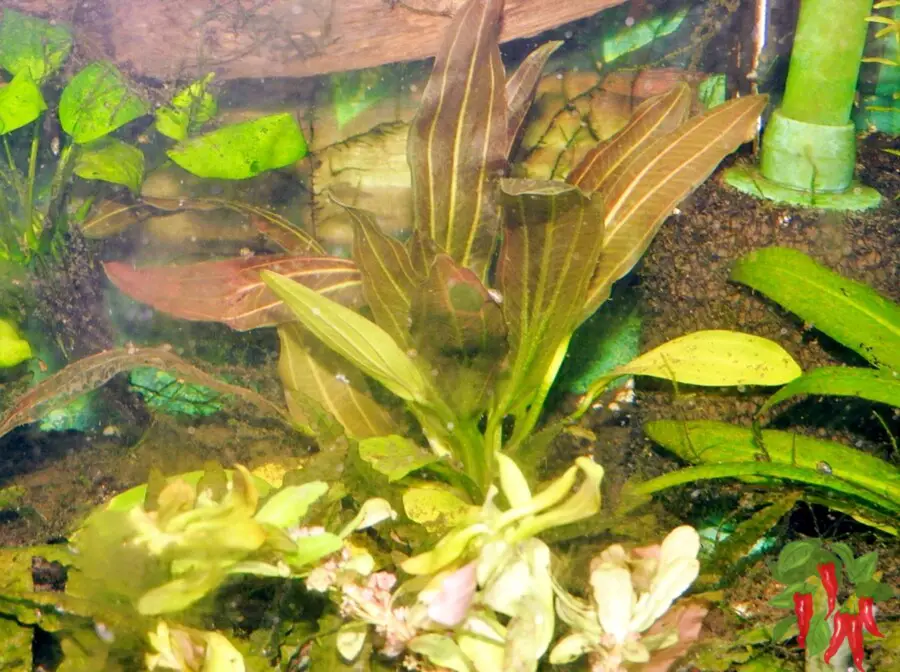
Getting your Red Rubin Sword planted the right way is super simple, and doing it right from the start helps it thrive long-term.
Whether you’re brand new to aquascaping or just adding to your collection, this part’s a breeze.
🧼 Step 1: Unpack and Clean the Plant
- Your plant will usually arrive in a small plastic pot
- Inside, it’s wrapped in rock wool (a spongy material that holds moisture)
- Gently remove the plant from the pot
- Carefully pull off the rock wool. Don’t rip the roots!
- 👀 Inspect the roots for snails or eggs, especially if you don’t want them in your tank
🌱 Step 2: Plant It in the Substrate
- Use aquarium-safe tweezers or your fingers to plant the roots
- Bury the roots, but don’t bury the crown (the thick part where roots and leaves meet). It can rot!
- Best planted directly in the substrate in a low-flow area
💊 Step 3: Add Nutrients
- Drop a root tab near the base of the plant to boost growth
- Red Rubin loves nutrient-rich soil but does fine with gravel or sand if tabs are used
- You can also use liquid fertilizers once it’s established, but root tabs are key
💡 Quick Tip
- Want to anchor it to driftwood or decor temporarily?
You can gently tie it with fishing line until it roots in, but ideally this plant needs to grow in the substrate.
This plant is tough, so even if you’re not perfect with your planting technique, it usually settles in just fine.
🧪 Care Tips for a Healthy Red Rubin Sword
The Red Rubin Sword is low-maintenance, but a little extra care goes a long way.
If you give it the right nutrients and light, it’ll reward you with steady growth and rich color.
💡 Light Requirements
- Grows well in low to medium light
- Doesn’t need high light, but more light can boost the red tones
- Avoid placing it in deep shade where it won’t get enough exposure
🌿 Substrate and Root Feeding
- Loves nutrient-rich substrates like Fluval Stratum or Eco-Complete
- If you’re using sand or gravel, add root tabs regularly
- Replenish tabs about every 4–6 weeks for consistent growth
💧 Water Conditions
- Temperature: 72–82°F
- pH: 6.5–7.5
- Hardness: Soft to moderately hard water
- Weekly water changes help prevent algae and keep it happy
🚫 CO₂ and Fertilizer Needs
- CO₂ is optional not required, but it’ll grow faster if you use it
- Benefits from liquid fertilizers with micronutrients
- Watch for yellowing leaves; it may need iron or potassium
✂️ Trimming and Maintenance
- Remove old or melted leaves at the base with scissors
- Don’t trim the crown, it can stop the plant from regrowing
- This sword doesn’t spread aggressively, so it stays tidy
Keep it rooted, fed, and lit and this plant will take care of the rest.
❓ Common Questions About Red Rubin Sword
Thinking about adding this plant to your tank but still have a few questions? You’re not alone.
Here are the answers to the things most folks want to know before planting a Red Rubin Sword.
🟥 Q. How red does the Red Rubin Sword actually get?
A. Pretty red! New leaves can show deep burgundy or even maroon tones, especially with good lighting and nutrients. Older leaves tend to fade to greenish-red, but the plant always keeps some color.
💡 Q. Does the Red Rubin Sword need CO₂?
A. Nope. It grows just fine without CO₂, which makes it great for beginners. That said, if you’re running CO₂ in your tank, the plant will grow faster and might show deeper red tones.
🐠 Q. Is it safe for fish, shrimp, and snails?
A. Totally. It’s a peaceful plant that doesn’t release any toxins or mess with your water quality. In fact, its broad leaves give shrimp and fry a great place to hang out or hide.
🌿 Q. Can it grow out of the water?
A. Yes, it can grow emersed in humid setups like paludariums. But most hobbyists keep it fully submerged in aquariums where it shows off those deep colors best.
🪴 Q. Does it grow from runners or need propagating?
A. It doesn’t send out runners like some sword plants do. You can divide the plant at the base once it gets large, but it’s a slow grower and usually just stays put.
🌿 Red Rubin Sword vs Amazon Sword: What’s the Difference?
Both plants belong to the Echinodorus family, and they share a lot of traits. But if you’re choosing between the two, here’s how the Red Rubin Sword stacks up against the classic Amazon Sword.
🎨 Color and Appearance
- Red Rubin Sword: Rich red to burgundy leaves, especially when new
- Amazon Sword: Bright to medium green leaves with no red tones
- Red Rubin offers a pop of color that the regular version doesn’t
🌱 Growth and Size
- Both grow about the same height, up to 12 inches
- Red Rubin may grow a little slower than the plain green variety
- Similar leaf shape and structure, making them great companions in a planted tank
🧪 Care and Needs
- Light: Both do well in low to medium light
- Fertilizer: Both love root tabs and benefit from liquid ferts
- CO₂: Not required for either plant
- Water conditions: Very similar and beginner-friendly
🐠 Tank Role
- Both work great as midground to background plants
- Their wide leaves give fish and shrimp shade and hiding spots
- Red Rubin makes a bolder visual statement, especially in colorful aquascapes
Red Rubin Sword vs Amazon Sword Comparison
| Scientific Name | Echinodorus ‘Red Rubin’ | Echinodorus amazonicus |
| Leaf Color | Red to burgundy | Bright to medium green |
| Typical Height | 6–12 inches | 6–12 inches |
| Light Needs | Low to medium | Low to medium |
| CO₂ Required | No (optional) | No (optional) |
| Ideal Tank Position | Midground or background | Midground or background |
| Visual Impact | High – bold red color | Classic green accent |
🛒 Where To Buy Red Rubin Sword Plants
Looking to add a Red Rubin Sword to your tank? You’re in luck, this plant is pretty easy to find if you know where to look.
Just make sure you’re getting a healthy specimen with strong roots and some red in the leaves.
🏪 Local Aquarium Shops
- Check your local fish store (LFS) or garden center with an aquatics section
- Ask if they carry Echinodorus ‘Red Rubin’ they might list it under a different name
- Look for plants with minimal damage and firm, red-tinted leaves
🌐 Online Retailers
Some solid online options that usually carry healthy stock:
- Amazon – Easy to order, just check seller reviews
- Canton Aquatics – Known for strong root systems and healthy plants
- Aquarium Co-Op – Reliable selection and beginner-friendly packaging
- BucePlant – Good for rare and hybrid plants
💡 Pro Tip: Always remove the plant from the pot and inspect the roots before planting. If you don’t want snails, rinse everything well and check the root zone carefully.
🌟 Final Thoughts: Why Red Rubin Sword Deserves a Spot in Your Tank
If you’re looking for a plant that adds both beauty and balance to your aquarium, the Red Rubin Sword is an easy win.
It’s bold, beginner-friendly, and surprisingly low maintenance, making it a favorite for hobbyists of all levels.
❤️ A Pop of Color Without the Fuss
- No CO₂ needed
- Grows in low to medium light
- Brings a deep red tone that stands out in green-heavy tanks
🧼 Clean Look, Clean Tank
- Helps absorb nutrients, which can reduce algae
- Gives shrimp and small fish places to hide
- Keeps your tank looking lush and healthy without constant upkeep
💪 Tough Enough for Beginners
- Doesn’t melt easily like some other red plants
- Strong roots anchor it in place, even in tanks with diggers
- Thrives with root tabs and regular water changes
🪴 Your Next Favorite Plant?
If you’ve been burned by “red” plants that turn green or melt away, this one might just change your mind. Give it a spot in your aquascape. You’ll be glad you did.
Planted Aquariums: A Beginner’s Guide to Success
❓ Red Rubin Sword FAQs
Got a few last questions before adding this bold beauty to your tank? Here’s a quick roundup of the most common things people ask about the Red Rubin Sword.
Q. Does the Red Rubin Sword really stay red?
A. Yes, especially when it’s healthy! New leaves come in burgundy or reddish-maroon. With good lighting and nutrients, the color holds well, though older leaves may fade slightly over time.
Q. How fast does the Red Rubin Sword grow?
A. It’s a moderate grower. You won’t see crazy fast growth, but it steadily fills out over time, especially with root tabs and good lighting.
Q. Can I grow this plant in gravel?
A. Absolutely. Just make sure you use root tabs since gravel doesn’t provide nutrients. As long as the crown is above the substrate, it’ll do just fine.
Q. Is this plant good for beginners?
A. 100%. It’s tough, adaptable, and doesn’t need CO₂ or special lighting. As long as you give it root tabs and decent water, it’ll thrive.
Q. Can I grow Red Rubin Sword with other swords?
A. Yes! It pairs well with green Amazon Swords or other Echinodorus varieties. Just space them out so they don’t compete for root space.
Visit my Amazon Influencer Page for videos and gardening products Grow Your Own Garden



